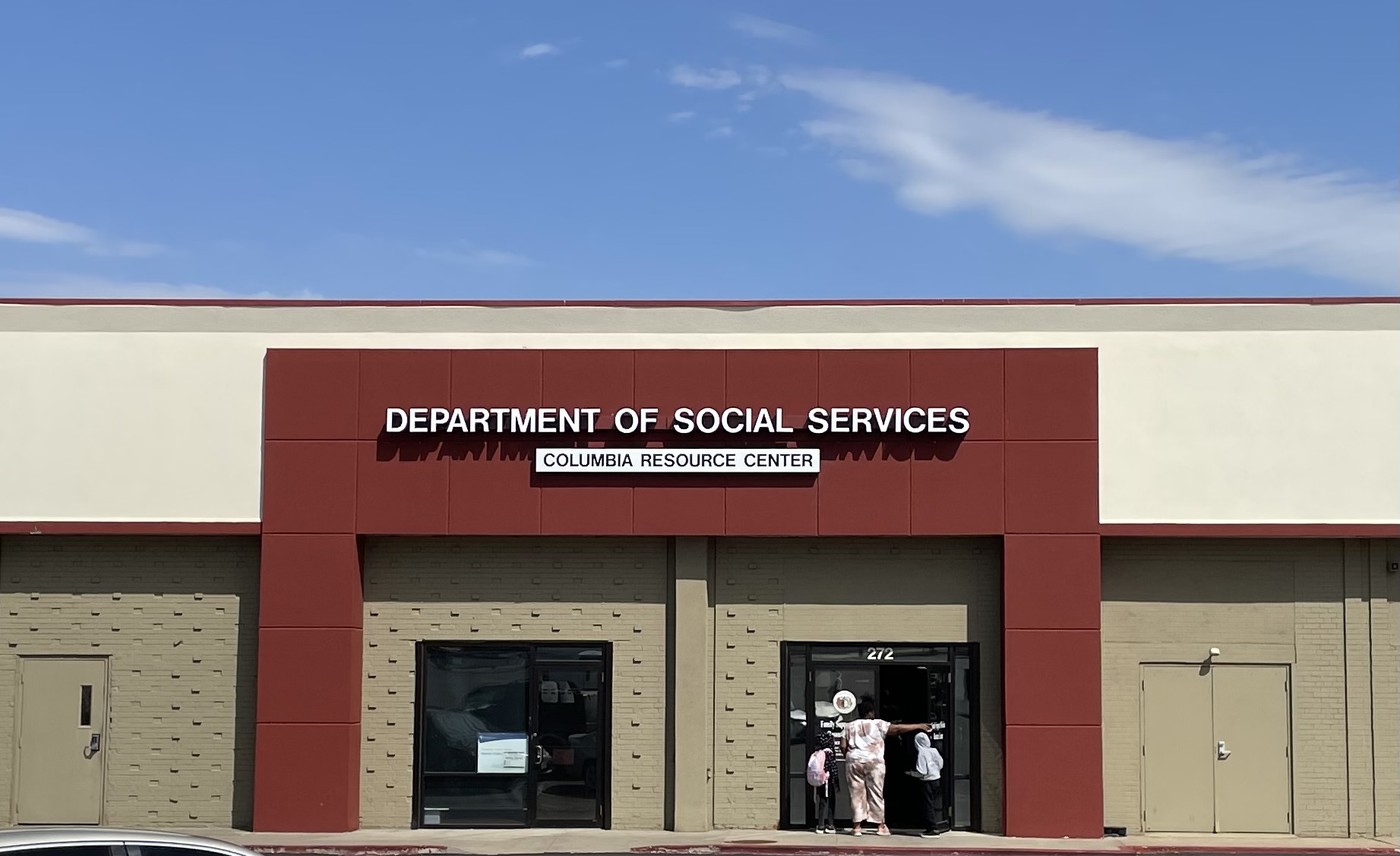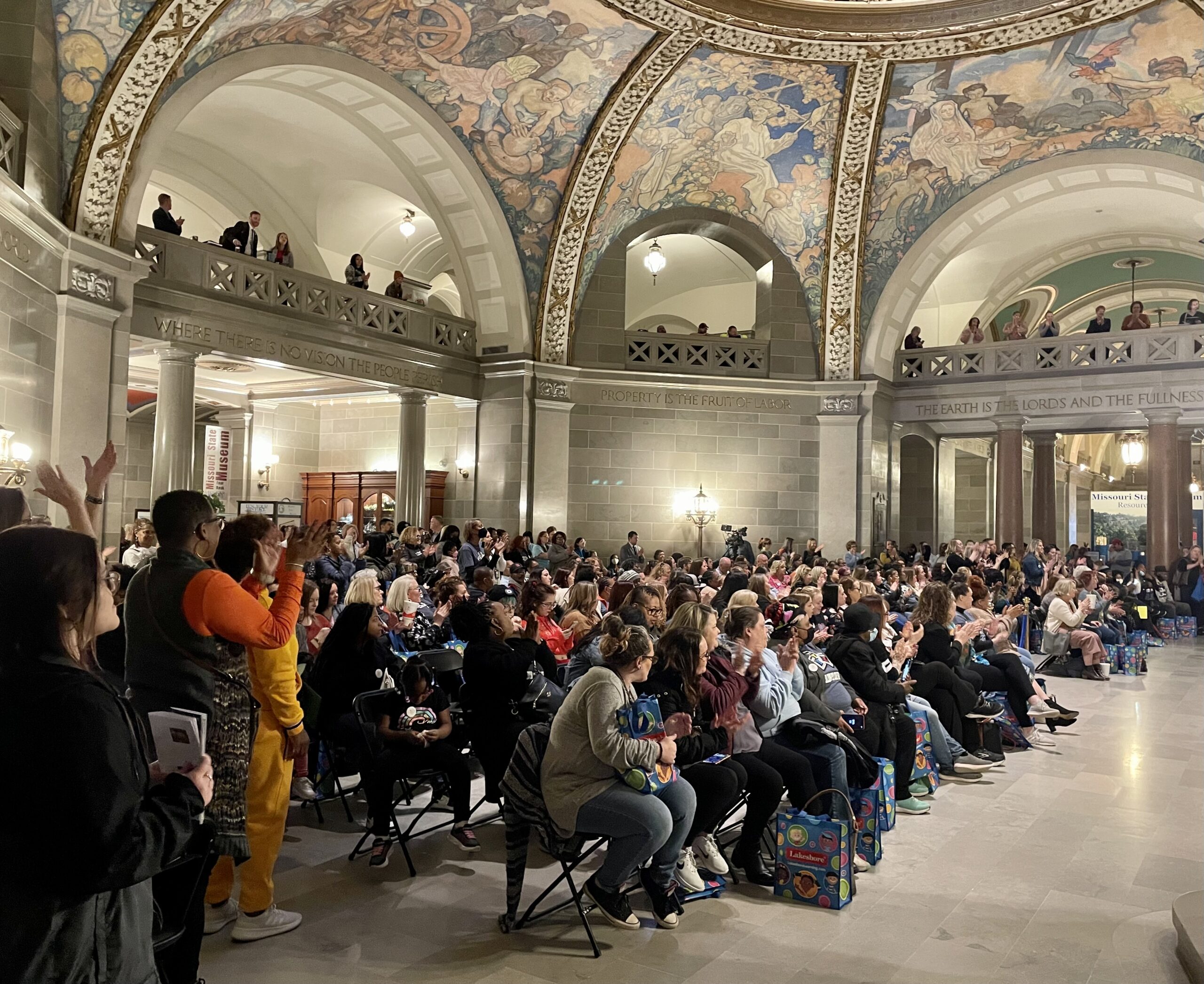
CALIFORNIA, Missouri — A federal subsidy program administered by the state helps Christa Swillum cover child care for her three young children.
Without the subsidy, which cuts her daycare bill in half, the single mother wouldn’t be able to afford the $1,600-a-month cost.
But getting the assistance took nearly eight months, as she had to apply over and over again, sit on the phone for hours and cover the full cost of daycare for her newborn and two toddlers. She needed to take a day off work last month to spend three hours on hold, then speak for two hours with a Department of Social Services staff member, to finally get approved for assistance.
“It’s nerve-racking…you send something off and you’re waiting and you’re waiting, and then all of a sudden you get like five letters in the mail from [the social services department]” she said. “And then one says one thing, one says another, and usually by time you get to the last one you’re like, I don’t even understand this.”
For low-income parents navigating the child care subsidy program in Missouri, bureaucratic hurdles can delay getting the financial help or restrict access to it entirely.
Meanwhile, some child care providers struggle to keep accepting the subsidy, citing low rates that don’t cover the cost of care, kids being dropped without notice from the program and difficulties getting paid by the state.

Over the last several months, The Missouri Independent and MuckRock have investigated the roots and possible solutions to overlapping crises of accessibility and affordability in the state’s child care industry as part of the “Disappearing Daycare” project.
Among the concerns raised by providers and low-income parents is the administration of the child care subsidy.
Navigating the program, which was designed to help those who are worst-off afford child care to be able to work, can itself become akin to a second job.
As part of a bipartisan push to improve child care access, Missouri Gov. Mike Parson proposed increasing the rate of reimbursement for providers who accept children on the subsidy — along with expanding school-based pre-kindergarten for low-income children and adopting several tax credits designed to improve access to child care.
Each has faced resistance in the legislature, despite bipartisan support. And while advocates say those policies would help, they wouldn’t fix the underlying problems that plague the state’s social safety net programs.
“The system is supposed to support work,” said Gina Adams, a child care policy expert at the D.C.-based Urban Institute. “It is supposed to support parenting. If you are requiring people to take off time from work [and] if the people who have trouble finding paperwork can’t get through it, you’re not designing a system that’s working for the people you’re trying to serve.”
Hours-long call center wait times

The child care subsidy is a federal program, administered by states through the Child Care and Development Block Grant. Families apply for the state to directly pay a child care provider part of the cost of care.
Only very low-income families qualify in Missouri, and foster kids — leaving assistance out of reach for many who can’t otherwise afford child care. In Missouri, the cutoff is 150% of the federal poverty line, equivalent to an annual income of no more than $41,625 a year for a family of four.
For a household of four with one person working full-time, that person would need to make no more than $20 per hour to qualify. Swillum makes $17 an hour, as a peer counselor at a health care nonprofit, and takes home around $2,200 per month, depending on her hours.
Just over 22,000 children are currently enrolled in the program, as of March. Parents generally need to pay the difference between what the provider charges and the state pays, which, in Swillum’s case, is still significant: around $800 per month.
The child care subsidy is one program administered by the Family Support Division within the Department of Social Services — along with Supplemental Nutrition Assistance Program, known commonly as food stamps, the cash support program Temporary Assistance for Needy Families, Medicaid and others.
Families with questions about their applications can call the social services’ phone line. There are in-person resource centers and online options for help, too, though Swillum and others interviewed by The Independent say the best shot for getting help is by phone.
But the call center has, for the last few years, required a resource that is particularly scarce among low-income families seeking government assistance: time.
Callers with questions about child care, or seeking the required interview for the subsidy, faced a wait time that surpassed two hours from October 2022 to February of this year.
The peak during that period was in January, when the wait time to be connected to a staff member was just under three hours.
As of March, the wait was down to one hour and four minutes.
States vary in the call center model they use for social services, and there isn’t national data comparing them. Missouri, in budget requests from fiscal years 2019 to 2022, used a benchmark of five minutes as the goal for their call center average wait time for all customers. That benchmark didn’t appear in budget requests for fiscal year 2023 or 2024.
Oklahoma’s phone line for its child subsidy program had a wait time of 14 minutes in March. In Iowa, the wait time was just 2 minutes and 45 seconds.
The Missouri wait times for those seeking information on child care subsidy exceeded an hour last summer. And they jumped after the state decided in September to reorganize its call center to devote one call tier exclusively to interviews for SNAP and another to all other programs it handles, including child care.
Heather Dolce, spokesperson for the Department of Social Services, said the reorganization of the call center stemmed from staffing issues.
The reorganization came after a federal lawsuit filed last year pointed to long wait times for SNAP applicants — which exceeded three hours in early 2022. The lawsuit, which is ongoing, argues that the long wait times deprive SNAP recipients of benefits they qualify for by making it difficult for them to obtain the required interviews.
Three hours wasn’t the longest Swillum experienced — she said she’d waited closer to five hours late last year for child care subsidy help and to resolve issues with SNAP benefits.
Sometimes she multitasked, taking her child to doctor’s appointments while hold music and intermittent automated information played softly on speaker phone in her lap.
The social services department has dealt with delays in processing applications for the subsidy, too. At the end of last year, there was a backlog of more than 1,000 applications — for a program that receives only a few thousand new applications each month. That number is now down to 136 applications, as of March. Dolce said the backlog was due to the shift of eligibility staff who specialized in child care to help more broadly with other kinds of programs late last year.
The number of child care assistance applications pending for more than 15 days ballooned by over 900% from 2017 to 2022. The backlog has been reduced substantially over the past three months, state data shows.
The accuracy rate of processing child care applications was just 67% in fiscal year 2022, according to budget documents, down from 95% in 2020, the only two years for which the department appears to have published this data.
Families slipping through the cracks

The staff on the other end of the phone line need vast knowledge of several programs, which each have their own complex eligibility rules.
But the kind of knowledge gained through years of experience has become scarcer, as retention in the Family Support Division has worsened over the last few years — particularly among frontline staff who deal directly with the public. Roughly one-third of eligibility specialists working at the beginning of the fiscal year 2022 were gone by the end of the year.
Dolce said the department is hopeful retention will improve with recent pay hikes from the governor, and said they have seen early evidence that the pay hikes have begun to help. In March, Parson raised state workers’ salaries by 8.7% in an effort to improve employee retention rates and attract workers from the private sector.
There were 436 vacancies as of March 1 in the Family Support Division, which is equivalent to roughly one in seven allotted positions sitting empty. Of those, 255 are from the income maintenance division, which deals with benefits applications and eligibility.
The shrinking of staff in the Family Support Division predates the COVID years — not just in vacancies, but cuts. If the Family Support Division could fill all its vacancies and reach its fully-appropriated amount of staff, it’d still have 963 fewer workers than it did in fiscal year 2009.
Beginning in fiscal year 2011, leadership started reorganizing and consolidating the Family Support Division, reducing in-person options and cutting staff, while introducing new technology. Critics at the time warned the changes were making it harder for Missourians to receive benefits.
Child care subsidy applicants and recipients used to be assigned caseworkers who would help answer questions, said Sarah Gould, who has run Community Support Services of Missouri Early Learning Center in Webb City for more than 20 years.
“They don’t have an actual caseworker assigned to them anymore,” she said. “They go in the call queue of whoever they can get.”
Caseworkers also helped providers support families, said Lea Parker, director of youth and children’s services at Interfaith Community Services in St. Joseph.
“We used to be able to call [caseworkers], say hey, what do you need? Are you waiting on something? Do you need a work schedule?” Parker said. “Now we can’t do that anymore. We can’t talk to a caseworker because they don’t have individual caseworkers…we can’t even advocate for our families because there’s no one person to talk to.”
Callers likely won’t have the same eligibility specialist twice when they call back, and “they’re not going to know that family at all,” Parker added, or be from their own region.
Without the extra support, families can slip through the cracks.
It’s easy for parents to miss requests for more information, or not provide information in time, said Megan Huffman, who owns Rising Sun Learning Center in Kansas City.
She hears from parents who say that after they fill out the application, they “sit and wait” without much communication.
“So if they miss information…if they want another pay stub or maybe you scanned a document but the scanner messed up and they couldn’t read it — if you don’t respond and give them the information that they want within X number of days, they close that application,” Huffman said.
Some providers facing ‘constant battle’
The bureaucratic issues also impact providers more directly.
Sarah Gould runs a large child care center in Webb City and serves mostly children on the subsidy.
It’s not just applications the state has to process but authorization requests, she said, which connect the family to a provider in the state’s system so the child care provider can be paid.
Gould said sometimes the child’s authorization status changes without enough notice to either her or the parent, so she finds out weeks later that the state has pulled funding for the child.
“The state is behind in processing applications,” Gould said, “And so they may go back and say well, ‘that’s effective like 10 days ago.’ By the time I find out about it, it could be almost 30 days later.
“And I have to turn around and charge the family for them not having a subsidy and recoup those funds,” she said. “That’s happening a lot right now.”
Parents, then on the line for a cost they didn’t anticipate, often struggle to pay it, Gould said.
Parker, the St. Joseph provider, said it’s a “constant battle.”
“I’ve had [the state] just drop kids off [the subsidy] and we don’t even know why,” she said. “They just disappear from our list.”
Providers also say they often devote significant time to correcting payment errors by the state.
The number of payment dispute resolution requests that providers submitted more than doubled from September to January, according to data obtained from the Department of Elementary and Secondary Education through a request under Missouri’s Sunshine Law.
The Department of Elementary and Secondary Education, since mid-2021, has overseen the Office of Childhood, and is responsible for handling providers’ payments and authorization requests. The social services department is still in charge of processing families’ applications.
Mallory McGowin, spokesperson for the Missouri Department of Elementary and Secondary Education, pointed to two reasons for that increase in disputes:
In September, the state changed the way it reimbursed providers, reverting back to the pre-pandemic model of payment by attendance of children on subsidy rather than simply whether or not they were enrolled in the program. The state would no longer pay for days the child was absent, beyond five days. If providers couldn’t adjust attendance information in their systems, McGowin said, they then needed to submit resolution forms.
The other potential cause, she added, was that in October there was a “coding issue in the system” that meant some providers needed to correct the state’s payments.
The issues ebb and flow over the months — in late 2020, the backlog of payment resolution forms at one point topped 5,000 — but providers say that the general trend over the last few years has been to make it more difficult to participate in the program.
Huffman, the Kansas City provider, said accepting the subsidy and getting paid properly has “gotten more and more complicated over the years.”
“I’ve had to go through and put pen to paper to make sure that what is in the system as being authorized is what is actually getting deposited into my account,” she said “And I’ve probably spent more time double checking that and finding errors and then having to go back and put in payment resolution requests — I’ve probably done that more in the last year or two than in the five years before.”
A path forward for legislative action?

Addressing the lack of affordable child care in Missouri was one of the few issues both Republicans and Democrats seemed to agree on entering the 2023 legislative session.
Parson proposed increasing the subsidy rate the state pays providers, to help bring the reimbursement rate closer to the rates providers are charging private-pay families.
Missouri’s 2022 market rate survey, which asked providers what they charge, showed it now pays providers at the 25th percentile toward the cost they charge, on average, for infant care, the 22nd percentile for 4 and 5 year olds, and 21st for school-aged children.
The rate increase would bump the rates up to the 58th percentile across the board — the level it was at last time they did the survey in 2018. The state would pay more of the cost of care and families, generally, would pay less.
The federal government recommends states pay providers at the 75th percentile of market rates, but few do.
Karen Schulman, who has researched subsidy policy for years at the D.C.-based National Women’s Law Center, said the change would be important but insufficient.
“Missouri’s had very low rates for a long time,” she said. “So it’s certainly essential to get these payment rates up…so [providers] don’t turn away a family receiving child care assistance in favor of a private paying parent who is paying their actual full fee.”
Parson included $78 million in his proposed budget to cover the cost of an increase.
The Missouri House, in their version of the budget, removed the subsidy rate increase, citing concern that the rates hadn’t been set properly. The Senate restored it. Most expect that funding to remain as lawmakers finish up their work on the state’s $50 billion budget this week.
Two other pieces of Parson’s child care agenda were an extra $55.8 million in state funding to boost access to public school-based pre-k for low-income families and various tax credits to expand access.
The pre-k expansion proposal was contentious in the House budget debates — some lawmakers raised concerns school districts wouldn’t be ready to host pre-k, or that it was too costly, and others argued a universal program would be fairer.
That proposal has been contentious among providers, too. Some raised concerns that drawing kids into public programs would reduce their revenue by taking pre-school aged children from their businesses, who are less labor and cost-intensive to care for than infants.
While Parson’s push to raise the subsidy and expand pre-K will likely find success through the budget, the fate of tax credits is less clear.
The tax credits — for donors to child care facilities, employers who pay for employees’ child care costs, providers themselves, and parents — have run into opposition from conservative senators who question their cost and effectiveness.
One tax credits proposal aims to help providers pay their staff more by refunding their payroll taxes. Other tax credits aim to incentivize employers to provide child care.
Sen. Lauren Arthur, D-Kansas City, is sponsoring legislation that includes those tax credits. She said proponents are “working on finding a path” forward for it, despite conservative opposition.
“We are trying to find some compromise and a way to get it done,” Arthur said. “There isn’t anything finalized, but we feel like there’s still time and there are different options available to us to get it done.”
Rep. Hannah Kelly, R-Mountain Grove, is sponsoring tax credit legislation that would provide parents up to $1,800 per year in child care refunds. Kelly’s tax credit was added on to the main bill with the other credits, in the latest House committee substitute.
She said in an interview she remains hopeful the tax credits will pass.
“I know there’s ongoing conversations across the board,” she said. “I know that efforts are being made to continue the conversation at all levels.”
Sam Lee, longtime lobbyist for the anti-abortion organization Campaign Life Missouri, has been a vocal proponent of Kelly’s tax credit legislation. He said its fate will be decided in the Senate.
“I just don’t know where that’s going to end up,” he said.
Kelly said she knows that neither her tax credit bill nor any single funding boost will solve the larger issues of access single-handedly. The bureaucratic hurdles, she said, must also be addressed.
“I want to be very clear when I say that I believe that money is not the only answer,” she said. “We’ve got to make sure that redundancy and red tape is not getting in the way of daycare providers serving those who need subsidy care.”
Arthur said she hopes the child care efforts this session are the beginning of more extensive change, including identifying the barriers for families to access assistance.
“I don’t think we’re going to build out our childcare infrastructure overnight. That’s probably a first, really good step of what will take many steps to fix this problem.”
Derek Kravitz and Dillon Bergin of MuckRock, and Rudi Keller of The Independent, contributed to this story.
Header image by Elianna Gregory




